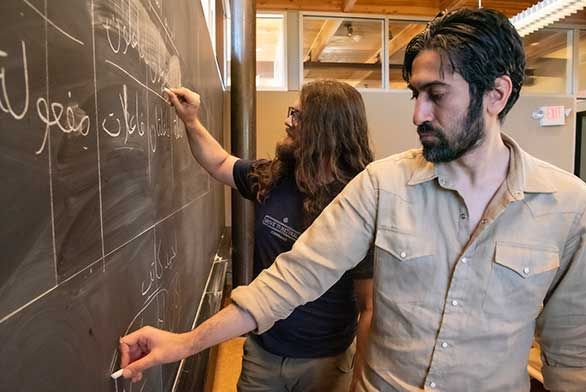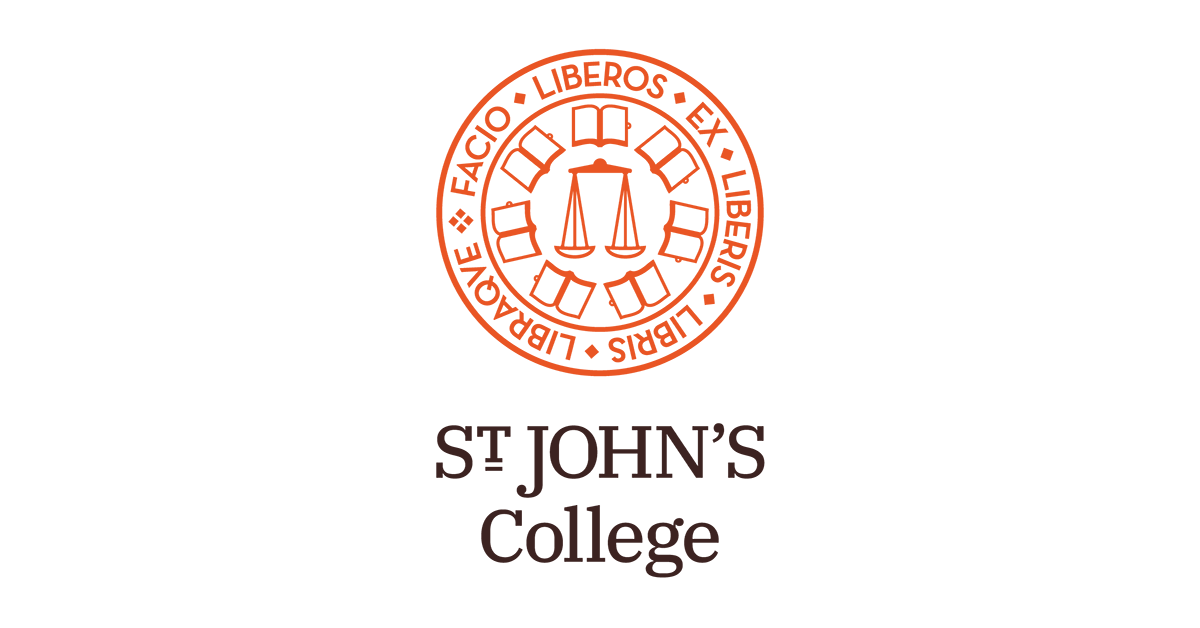St. John’s Santa Fe Debuts Long-Awaited Master of Arts in Middle Eastern Classics
June 25, 2025 | By Kirstin Fawcett (AGI27)
When St. John’s Sante Fe tutor Kenneth Wolfe (SF94) completed his BA, he embarked on a well-paved route for Johnnies: a PhD in the classics, with a focus on ancient Greek philosophy. However, the scholar-in-training soon encountered a fork in the road for which he had no Program-provided map. It stretched beyond the Mediterranean and across the Middle East, a region home to a host of figures who had lived, taught, and produced seminal works between the fall of Rome and the European Renaissance. These intellectuals were synergistic with the Western canon—they had, after all, preserved and transmitted key Greek philosophical and theological traditions while informing Christianity, Judaism, and Islam—yet deserving of their own space in the global conversation. When Kenneth Wolfe returned to his alma mater as a tutor in 2002, he carried their names with him, believing that they deserved to be studied at St. John’s College alongside the great thinkers of Europe, China, and India. “I thought one of the major gaps in the Program was Middle Eastern classics,” he says.

Kenneth Wolfe wasn’t the only Santa Fe tutor with this conviction—and collectively, their resolve snowballed into decades of proposals and planning, culminating in the launch of a long-awaited Master of Arts in Middle Eastern Classics (MAMEC) this fall. It’s the Santa Fe campus’s first new degree program in more than 30 years and a long-term labor of love for a group of faculty that, in addition to Kenneth Wolfe, includes Associate Dean for Graduate Programs David Carl as well as tutors Michael Wolfe (SF94), Krishnan Venkatesh, Obed Lira (SF10), and Alan Zeitlin, among others.
Students enrolled in the MAMEC will study the great texts of Jewish and Islamic civilizations, ranging from theology and philosophy to poetry, mysticism, history, and critiques of Aristotelianism. Completed in a single year over the course of three consecutive semesters—fall, spring, and summer—its core class is the discussion-based St. John’s seminar, supplemented by language tutorials in classical Hebrew or Arabic. Preceptorials will provide participants with the chance to look at single topics or authors more closely.
“I think this program offers something that is just not found in the landscape of higher education in the United States,” says Ahmed Siddiqi, a former faculty member and ongoing curricular advisor to the MAMEC whose academic background in medieval Islamic philosophy and theology informed its reading list. “To take a year and holistically study a group of texts that fill in this important part of intellectual history—I don’t think anybody else does that.”
The MAMEC, while new to St. John’s, is a natural extension of the New Program syllabus that serves as the basis for the BA and the Master of Arts in Liberal Arts, or MALA. Tutor Krishnan Venkatesh refers to its curriculum as the “underbelly of sophomore year” while explaining how the undergraduate program abruptly jumps forward at that juncture from Tacitus and ancient Rome to the European Middle Ages. “Suddenly, we’re finding that people like Dante and Aquinas are referring back to Jewish and Islamic philosophers,” he says. “They’ve been reading their stuff; they’ve been questioning.”
The MAMEC fills in these blanks, and “is very valuable in giving us continuity,” Venkatesh adds. “It provides a greater understanding of where the New Program is coming from, although it takes place in a distinct conversation between Hebrew, Arabic, and some Christian thinkers. We are justified in treating it as a separate master’s program because it has its own coherence.”
Some names on the MAMEC reading list, like Maimonides (a Sephardic rabbi who is read by Santa Fe undergraduates) and mystic poet Rumi, might look more familiar to Western eyes than others such as Islamic visionary ‘Ibn al-‘Arabī or al-Farabi, who’s been dubbed the “Father of Islamic Neoplatonism.” All of them, however, address big questions, many of which probe the relation between reason and revelation, the compatibility between human intellect and the divine, and the resulting implications for human life on earth in addition to expanding on Greek philosophy, science, and math.
St. John’s approach toward discussing these texts will remain identical to the way students have traditionally encountered materials in the undergraduate and graduate liberal arts programs, as well as in the Eastern Classics program: It’s just the student—alongside their classmates and tutor—and the book, with no middleman or prior knowledge required to interpret its meaning. Prospective MAMEC students don’t need a background in religious or Middle Eastern studies to enroll; what they do need to bring to the seminar table is the desire to engage civilly and expansively with program ideas among a diverse group of individuals.
“We believe that these books, like the ones in the MALA and Eastern Classics programs, are part of the common human heritage—they should be read, thought about, and discussed by all human beings,” says Associate Dean for Graduate Programs David Carl. “An individual’s degree of expertise should not be the limiting factor in their ability to encounter their words.”
While St. John’s famously rejects the notion of “expertise,” decades of trial, consideration, and care were poured into the MAMEC’s reading list, as well as its philosophy and design. Nascent sparks of its existence arose in Santa Fe in the 1970s or 1980s when retired tutor David Starr arranged on-campus dialogues between young Jewish and Muslim students. Faculty in Annapolis and Santa Fe, meanwhile, had expressed interest in the degree for years, at turns submitting draft proposals and reading lists. “In Santa Fe, at the undergraduate level, we had incorporated some of the MAMEC texts into the undergraduate seminar,” Carl says. “But we could never quite make room for all of them.”
Then 9/11 happened and students clamored to get into tutor Michael Wolfe’s preceptorial on the Qurʾān and the biography of Muhammad—which catalyzed his journey and role as a central force in developing the MAMEC. “Getting to this day has been one of the great joys of my life, because these texts have been so meaningful to me, and I’ve seen how meaningful they can be to my students,” Michael Wolfe says.
A decade or so ago, planning went into overdrive when the Santa Fe campus orchestrated a summer intensive pilot of what would ultimately become the year-long MAMEC. Since then, “we have had faculty leading study groups and preceptorials, reading these works while preparing a coherent curriculum we could turn into an actual for-credit master’s degree,” Carl says. An instructional proposal was approved with enthusiastic support from former St. John’s Collegewide President Mark Roosevelt, and when Santa Fe dean and tutor J. Walter Sterling stepped into Roosevelt’s shoes as college leader, he began fundraising for the MAMEC in earnest. “It’s thanks to a handful of very generous donors that we were finally able to build, launch, and support the MAMEC,” Carl says. “We’ve been academically ready for years, and now we’re financially ready.”
The MAMEC might eventually be available as a low-residency program; for now, it’s limited to in-person participants, starting with a pilot this fall, comprising a small cohort of 19 students. Among them is Shelley Mason (SFGI14, EC16), who is returning to Santa Fe from her hometown of Kansas City to explore a new textual tradition—and by extension, her heritage—through the MAMEC.
Growing up, Mason hadn’t known her father was Jewish; later, she discovered he had changed his name from Rosenberg before entering the army in World War II. Through the MAMEC, she hopes to learn the traditions and philosophies undergirding this lineage the way she’s become accustomed to at St. John’s: open-mindedly, thoroughly, and on her own terms. “I’ve been interested in the MAMEC for years, ever since I first heard about it,” Mason says. Now, finally, she’ll get to do it—stepping into a tradition that once bridged civilizations and may yet again.
Applications for the MAMEC’s Fall 2026 cohort open to the public in September 2025. Learn more here.

